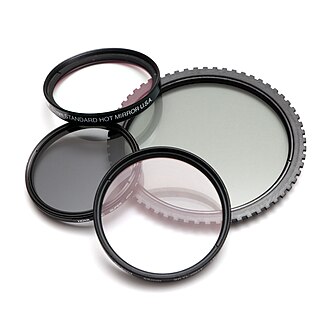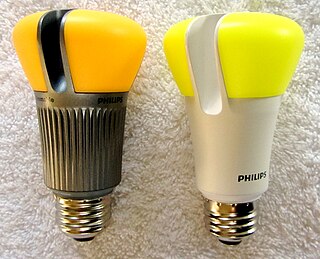
The color temperature of a light source is the temperature of an ideal black-body radiator that radiates light of a color comparable to that of the light source. Color temperature is a characteristic of visible light that has important applications in lighting, photography, videography, publishing, manufacturing, astrophysics, horticulture, and other fields. In practice, color temperature is meaningful only for light sources that do in fact correspond somewhat closely to the radiation of some black body, i.e., light in a range going from red to orange to yellow to white to blueish white; it does not make sense to speak of the color temperature of, e.g., a green or a purple light. Color temperature is conventionally expressed in kelvins, using the symbol K, a unit of measure for absolute temperature.

Film stock is an analog medium that is used for recording motion pictures or animation. It is recorded on by a movie camera, developed, edited, and projected onto a screen using a movie projector. It is a strip or sheet of transparent plastic film base coated on one side with a gelatin emulsion containing microscopically small light-sensitive silver halide crystals. The sizes and other characteristics of the crystals determine the sensitivity, contrast and resolution of the film. The emulsion will gradually darken if left exposed to light, but the process is too slow and incomplete to be of any practical use. Instead, a very short exposure to the image formed by a camera lens is used to produce only a very slight chemical change, proportional to the amount of light absorbed by each crystal. This creates an invisible latent image in the emulsion, which can be chemically developed into a visible photograph. In addition to visible light, all films are sensitive to X-rays and high-energy particles. Most are at least slightly sensitive to invisible ultraviolet (UV) light. Some special-purpose films are sensitive into the infrared (IR) region of the spectrum.

In colorimetry, metamerism is a perceived matching of colors with different (nonmatching) spectral power distributions. Colors that match this way are called metamers.

Single-8 is a motion picture film format introduced by Fujifilm of Japan in 1965 as an alternative to the Kodak Super 8 format. The company Konan claims in its history page to have developed the Single-8 system in 1959.

Kodachrome is the brand name for a color reversal film introduced by Eastman Kodak in 1935. It was one of the first successful color materials and was used for both cinematography and still photography. For many years Kodachrome was widely used for professional color photography, especially for images intended for publication in print media. Because of its complex processing requirements, the film was sold process-paid in the United States until 1954, when a legal ruling prohibited that. However, the arrangement continued in other markets.

A color gel or color filter, also known as lighting gel or simply gel, is a transparent colored material that is used in theater, event production, photography, videography and cinematography to color light and for color correction. Modern gels are thin sheets of polycarbonate, polyester or other heat-resistant plastics, placed in front of a lighting fixture in the path of the beam.
Color photography is photography that uses media capable of capturing and reproducing colors. By contrast, black-and-white or gray-monochrome photography records only a single channel of luminance (brightness) and uses media capable only of showing shades of gray.

In photography and cinematography, a filter is a camera accessory consisting of an optical filter that can be inserted into the optical path. The filter can be of a square or oblong shape and mounted in a holder accessory, or, more commonly, a glass or plastic disk in a metal or plastic ring frame, which can be screwed into the front of or clipped onto the camera lens.

Velvia is a brand of daylight-balanced color reversal film produced by the Japanese company Fujifilm. The name is a portmanteau of "Velvet Media", a reference to its smooth image structure. The original incarnation of the film was called "Velvia for Professionals", known as RVP, a classification code meaning "Reversal/Velvia/Professional series". It is known for its extremely high level of color saturation and image quality.

Day for night is a set of cinematic techniques used to simulate a night scene while filming in daylight. It is often employed when it is too difficult or expensive to actually shoot during nighttime. Because both film stocks and digital image sensors lack the sensitivity of the human eye in low light conditions, night scenes recorded in natural light, with or without moonlight, may be underexposed to the point where little or nothing is visible. This problem can be avoided by using daylight to substitute for darkness. When shooting day for night, the scene is typically underexposed in-camera or darkened during post-production, with a blue tint added. Additional effects are often used to heighten the impression of night.
Color correction is a process used in stage lighting, photography, television, cinematography, and other disciplines, which uses color gels, or filters, to alter the overall color of the light. Typically the light color is measured on a scale known as color temperature, as well as along a green–magenta axis orthogonal to the color temperature axis.

Color motion picture film refers both to unexposed color photographic film in a format suitable for use in a motion picture camera, and to finished motion picture film, ready for use in a projector, which bears images in color.

Fujicolor Superia is a Fujifilm brand of daylight balanced colour negative film introduced ca.1998 primarily aimed at the consumer market, but was also sold in a professional 'press' variant. A key feature at launch was the '4th' cyan colour layer designed to provide improved colour reproduction under fluorescent lighting. Its Kodak equivalent is the Kodacolor Gold/Ultramax line.
Fujicolor Pro was a line of professional color negative films from Japanese company Fujifilm introduced in 2004 for weddings, portraits, fashion and commercial photography. It originally comprised four emulsions: Pro 160S, Pro 160C, Pro 400H and Pro 800Z. Its main competitor was Kodak Portra.

Photographic film is a strip or sheet of transparent film base coated on one side with a gelatin emulsion containing microscopically small light-sensitive silver halide crystals. The sizes and other characteristics of the crystals determine the sensitivity, contrast, and resolution of the film.
The color rendering of a light source refers to its ability to reveal the colors of various objects faithfully in comparison with an ideal or natural light source. Light sources with good color rendering are desirable in color-critical applications such as neonatal care and art restoration. It is defined by the International Commission on Illumination (CIE) as follows:
Color rendering: Effect of an illuminant on the color appearance of objects by conscious or subconscious comparison with their color appearance under a reference illuminant.

High-CRI LED lighting is a light-emitting diode (LED) lighting source that offers a high color rendering index (CRI).
The Academy Color Encoding System (ACES) is a color image encoding system created under the auspices of the Academy of Motion Picture Arts and Sciences. ACES allows for a fully encompassing color accurate workflow, with "seamless interchange of high quality motion picture images regardless of source".

Cinestill Film creates photographic film for still cameras in 135 and 120 film formats from modified Kodak motion picture cinema film stock.













